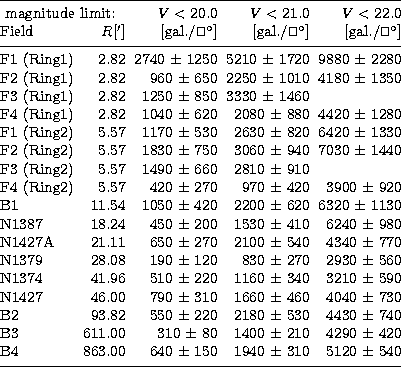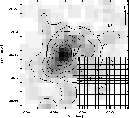We investigated the spatial distribution of all galaxies in order to
look for a possible over-abundance of dwarf galaxies in the center of the
Fornax cluster. Therefore, we calculated the galaxy densities in the different
fields.
We define in the following all CCD fields except the NGC 1399 and B1 field
as local Fornax background in contrast to the cluster center region.
The background fields B3 and B4 were used to estimate the absolute galaxy
background counts.
The galaxy counts in the central fields F1 - F4 were divided into two rings
around the center of NGC 1399, one extending from ![]() to
to ![]() ,the other from
,the other from ![]() to
to ![]() .Table 3 lists the galaxy density per square degree for the
different fields as a function of limiting V magnitude. Note that for
magnitudes fainter than V = 21 mag the SW field of NGC 1399 (F3) has been
omitted due to the shorter exposures in this field. In all the other fields,
no incompleteness effects influence the galaxy counts for magnitudes
brighter than V = 22 mag (see Sect. 7).
.Table 3 lists the galaxy density per square degree for the
different fields as a function of limiting V magnitude. Note that for
magnitudes fainter than V = 21 mag the SW field of NGC 1399 (F3) has been
omitted due to the shorter exposures in this field. In all the other fields,
no incompleteness effects influence the galaxy counts for magnitudes
brighter than V = 22 mag (see Sect. 7).
 |
In Fig. 9 we plotted the galaxy densities for galaxies brighter than V = 21 mag in relation to the radial distance along the east, respectively west, sequence of our fields with NGC 1399 in the center. The densities of the absolute background fields B3 and B4 are shown as comparison in both directions.
It is striking that the central fields, except F4 and F2 (ring 1), have about 2-3 times higher density values than the other fields. There exists an excess population of galaxies near NGC 1399. Further, the galaxy density in the eastern fields is in the mean higher than in the western fields, whose densities are comparable with or even lower than that of the absolute background fields. However, nearly all density values are equal within the errors that result from the density variations and clustering properties of background galaxies. This makes it nearly impossible to distinguish a possible excess of faint and compact dwarf galaxies, which represent only a few percent of the galaxy counts, from background variations.
The excess of galaxies in the central fields can be explained by
a background galaxy cluster at z = 0.11 just behind the center of the
Fornax cluster. In Paper II we give a detailed analysis of radial
velocity measurements of the brightest galaxies in this region.
In Fig. 10 we show a galaxy density map of the four central Fornax
fields. We constructed this map by counting galaxies
with 16.0 < V < 21.5 mag and (V-I) < 1.6 mag in bins of ![]() pixel (
pixel (![]() arcmin2). This sample contains 189 galaxies.
The "density pixels'' then were
smoothed by a
arcmin2). This sample contains 189 galaxies.
The "density pixels'' then were
smoothed by a ![]() average filter. Their values range between
0 (white) and 3.5 (black) galaxies per arcmin2.
Note that the counts in the SW field (F3) and the central "density pixel''
are not complete. In the other fields the counts are 100% complete.
One can clearly see a banana shaped galaxy distribution east of NGC 1399.
Galaxies with observed redshifts of z = 0.11 (see also Paper II) match the
distribution of high galaxy density very well. We suspect that nearly
all excess galaxies in the center belong to the background cluster. Thus,
no large excess of dwarf galaxies exists around NGC 1399.
average filter. Their values range between
0 (white) and 3.5 (black) galaxies per arcmin2.
Note that the counts in the SW field (F3) and the central "density pixel''
are not complete. In the other fields the counts are 100% complete.
One can clearly see a banana shaped galaxy distribution east of NGC 1399.
Galaxies with observed redshifts of z = 0.11 (see also Paper II) match the
distribution of high galaxy density very well. We suspect that nearly
all excess galaxies in the center belong to the background cluster. Thus,
no large excess of dwarf galaxies exists around NGC 1399.
In Fig. 11 we show the distribution of point sources around
NGC 1399. We selected all objects with classifier values larger than 0.86,
magnitudes between 20.5 < V < 22.0, and colors in the range 0.6 < (V-I) <
1.6, in total 248 objects. The isodensity contours have levels between 1.1
and 6.8 objects per arcmin2. The contribution of background objects was
determined by counting point sources in the local background field B2. With the
same selection criteria 0.13 objects per arcmin2 have been counted.
Thus, about 90% of the
point sources should belong to the GCS of NGC 1399
or the background galaxy cluster. Again, the counts in all fields except F3
are 100% complete (see also Kohle et al. 1996).
The peak of the distribution is located
about ![]() east of NGC 1399. This result has to be considered
with caution,
since the counts in the central density pixels as well as in the SW field
are not complete. However, we found that this effect also (even more
pronounced) occurs when taking brighter samples of point sources, which
should not be affected by incompleteness effects.
In previous investigations of the GCS of NGC 1399, the properties of GCs in
the NE (F2) and NW (F4) field have been examined (Kissler-Patig
et al. 1997). We found that the radial surface density profile
of the GCs (centered on NGC 1399) is shallower in the NE field than in the
NW field. Furthermore Forbes et al. (1998) investigated
the angular distribution of GCs within 100
east of NGC 1399. This result has to be considered
with caution,
since the counts in the central density pixels as well as in the SW field
are not complete. However, we found that this effect also (even more
pronounced) occurs when taking brighter samples of point sources, which
should not be affected by incompleteness effects.
In previous investigations of the GCS of NGC 1399, the properties of GCs in
the NE (F2) and NW (F4) field have been examined (Kissler-Patig
et al. 1997). We found that the radial surface density profile
of the GCs (centered on NGC 1399) is shallower in the NE field than in the
NW field. Furthermore Forbes et al. (1998) investigated
the angular distribution of GCs within 100![]() (= 5 "density pixels''
in a HST WFPC2 image that covers the NE part of the center of NGC 1399).
They found a peak in the angular distribution in the east
direction. Both results are consistent with our finding of an excess of
point sources east of NGC 1399. Note that in this direction also the density
of resolved objects is very high.
(= 5 "density pixels''
in a HST WFPC2 image that covers the NE part of the center of NGC 1399).
They found a peak in the angular distribution in the east
direction. Both results are consistent with our finding of an excess of
point sources east of NGC 1399. Note that in this direction also the density
of resolved objects is very high.
There are basically three possible explanations for this displacement. First, a significant amount of unresolved galaxies in the background cluster was counted together with the globular clusters. Since the background cluster lies east of NGC 1399 the peak of the distribution of all point sources would then be shifted to the east. In this case, the galaxies would have absolute magnitudes between -18.0 < MV < -16.5 mag and half light radii smaller than about 1.5 kpc assuming a distance of 480 Mpc to the background cluster. Such properties can only be explained by cEs, which are believed to represent only a negligible fraction of the galaxy population in the local universe. In the Fornax cluster, for example, Drinkwater et al. (1997, see also Drinkwater & Gregg 1998) investigated by radial velocity measurements that all galaxies in their sample that are classified as M 32 type compact ellipticals in the FCC are background galaxies. Further, in the HST counts GCs should be clearly distinguishable from galaxies even at z = 0.11. Second, the GCS is really displaced with respect to the bulge of NGC 1399. This would be a hint that the GCS follows another potential than the stellar light and may belong rather to the cluster as a whole than to NGC 1399 itself, as supported by the velocity dispersion measurements in Grillmair et al. (1994) and Kissler-Patig et al. (1998a). In this respect, it is worthwhile noting that the center of the gas distribution detected by X-ray observations is also displaced, to the north-east of NGC 1399 (Ikebe et al. 1996; Jones et al. 1997). Finally, somewhat similar to the latter point, the distribution of GCs might be a temporary displacement of a "normal'' GCS centered on NGC 1399. A scenario that supports this possibility is related to the enrichment of the central GCS by the accretion of GCs from other galaxies. Kissler-Patig et al. (1998b) suggest that tidal tails of GCs from the last passage of a Fornax galaxy might still be visible; these could mimic a skewed distribution of GCs around NGC 1399. Further investigations have to show if this riddle can be solved.
 |
Figure 11:
The same plot as in Fig. 10 for point sources (90% of
them are likely globular
clusters) between 20.5 < V < 22.0. The isodensity contours correspond to
6.8, 5.8, 4.9, 3.9, 3.0, 2.1, and 1.1 objects per arcmin2.
The distribution of point sources seems to be displaced by about |
Copyright The European Southern Observatory (ESO)